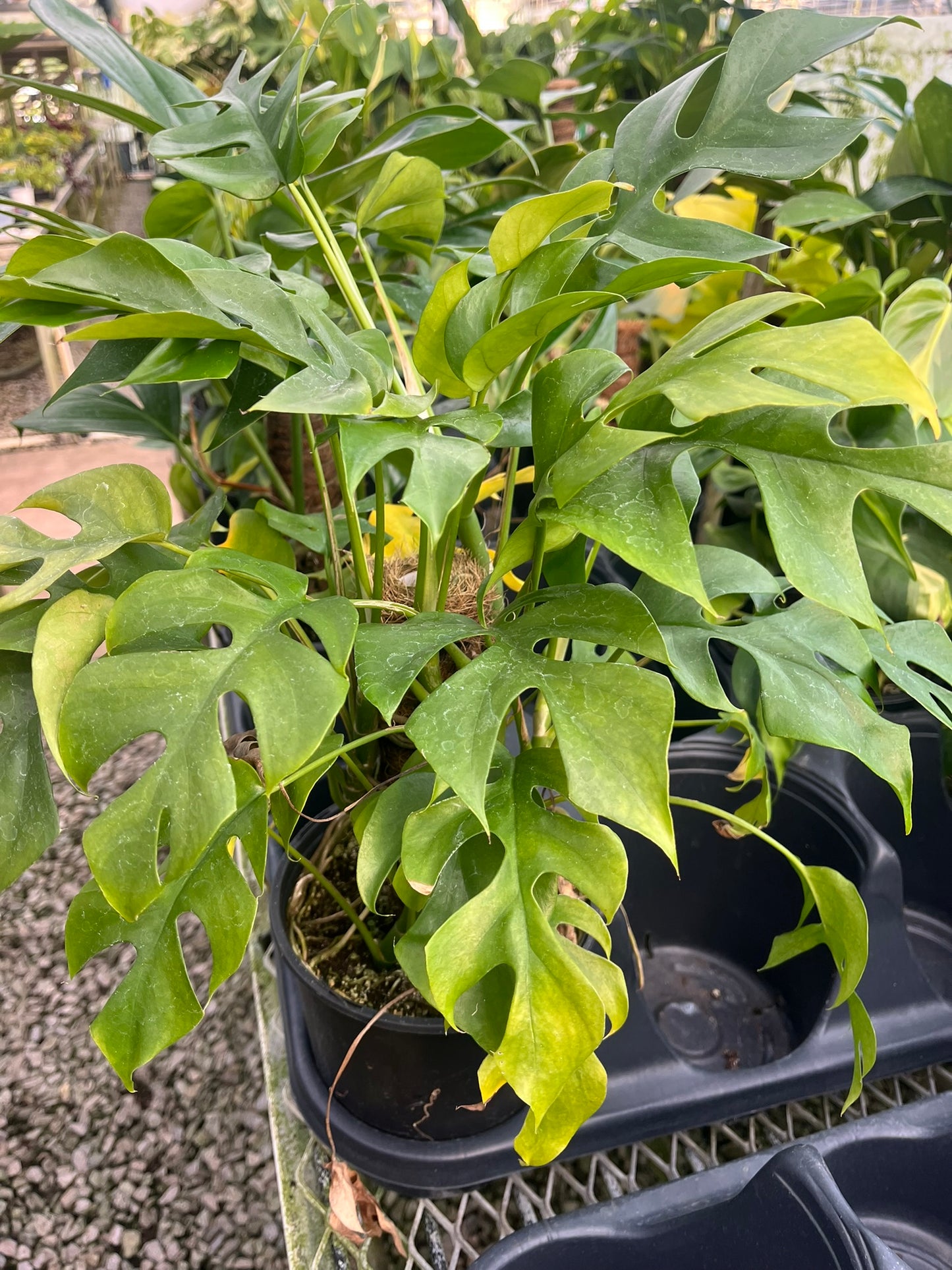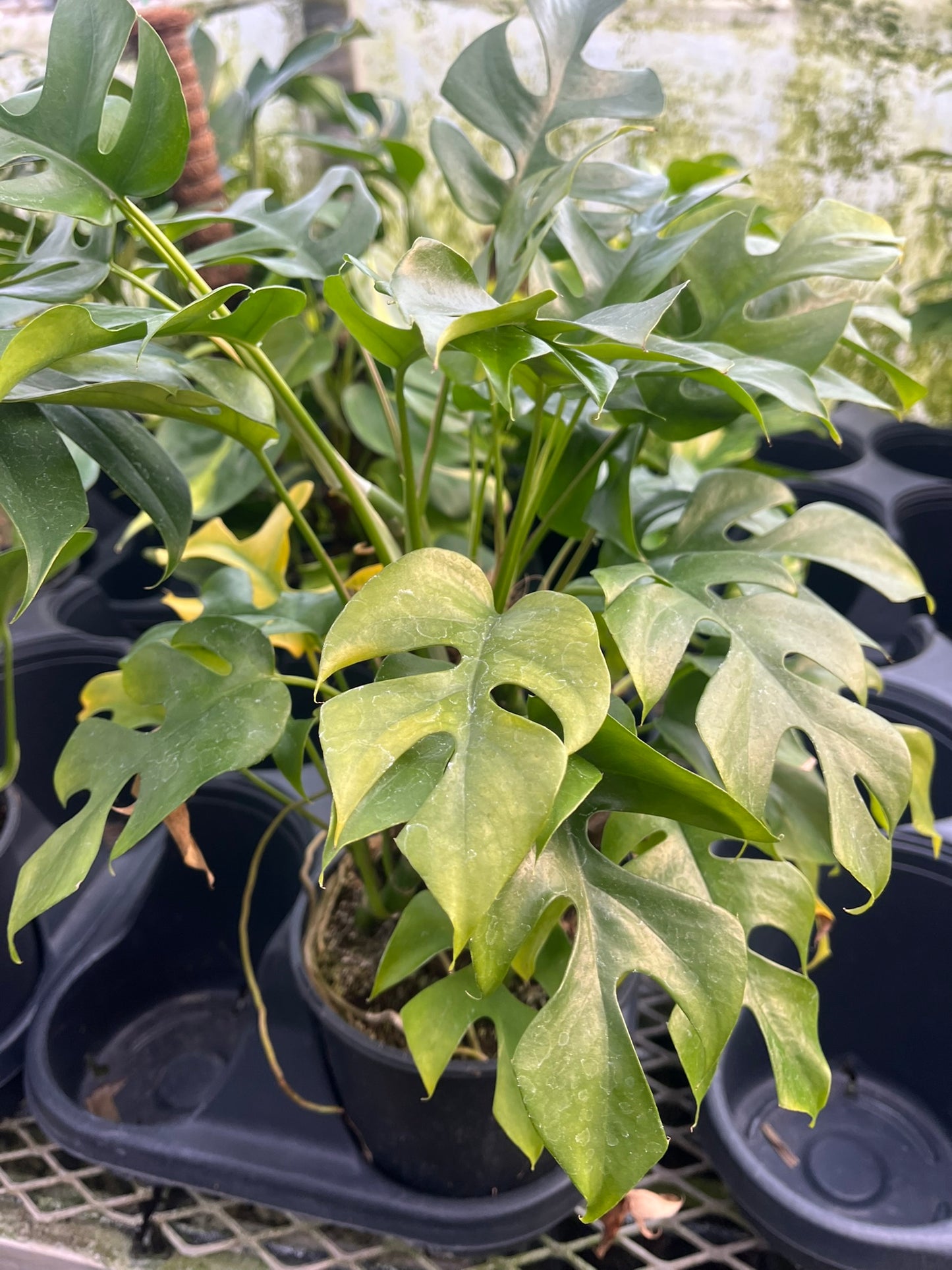Plant Hoarder
Rhaphidophora tetrasperma, Mini Climbing Monstera
Rhaphidophora tetrasperma, Mini Climbing Monstera
Couldn't load pickup availability
Share
Hardiness Zone:9
Sun Exposure:Part Sun, Mostly Shade and Shade
Rhaphidophora tetrasperma (Mini Climbing Monstera): Small Plant, Big Style
Meet the plant that gives you bold split leaves in a compact size. Rhaphidophora tetrasperma, often called Mini Monstera or Mini Climbing Monstera, looks like a tiny version of a classic Monstera—but it’s its own species with its own charm. In other words, you get the modern split-leaf look without the giant footprint. Perfect for shelves. Perfect for poles. Perfect for us.
Why We Love This Mini Marvel
We love plants that look high-end but act low-maintenance. This one checks every box. The leaves are glossy and deeply split. The vines are fast. The habit is neat. It climbs with ease and trails with grace. But most of all, it brings a tropical vibe that feels fresh and happy in any room.
Quick Facts (At a Glance)
-
Botanical name: Rhaphidophora tetrasperma
-
Common names: Mini Monstera, Mini Climbing Monstera
-
Growth style: Climbing aroid; can trail or climb
-
Mature size indoors: 4–8 ft with support
-
Light: Bright, indirect light
-
Water: When the top inch is dry
-
Humidity: Moderate to high preferred
-
Pet safety: Not pet-safe if chewed
-
Skill level: Beginner-friendly
What Makes It Special
Compact Design, Luxe Look
You get that split-leaf drama in a smaller package. Leaves develop cut-outs as the plant matures, giving a sculptural feel. Instead of a wild jungle giant, you get a tidy, modern accent that still makes a statement.
Fast Growth With a Little Support
Give it a pole or trellis and watch it climb. You’ll see new leaves, more splits, and a fuller look over time. After more than a few weeks in good light, the pace picks up. It’s rewarding to train and shape.
Easygoing Care
This plant isn’t fussy. Bright, soft light. Water when dry on top. Airy soil. That’s the formula. In other words, it’s a high-impact plant with low drama.
Light: Bright and Gentle Wins
Place it in bright, indirect light. A few hours of soft morning sun is fine. Midday, direct sun can scorch. If light is too low, new leaves may stay small and have fewer splits. Rotate the pot weekly so growth stays even.
Tip: If you’re using a grow light, set it for 8–12 inches above the canopy and run 10–12 hours daily. Steady light equals steady splits.
Water: Simple and Steady
Water when the top inch of soil feels dry. Pour slowly until water drains from the bottom, then empty the saucer. If leaves curl or droop and the mix feels dry, it’s time to water. If leaves yellow and soil stays wet, let it dry more between waterings. Instead of guessing by the calendar, use the touch test.
Humidity & Temperature: Cozy Air, Happy Leaves
Normal home humidity works, but 50%+ helps create lush growth. A small humidifier nearby is great, or set the pot on a tray of pebbles with water below the pot line. Keep temps between 65–85°F. Avoid cold drafts or hot vents. Stable air makes a calm plant.
Soil & Pot: Airy and Quick-Draining
Use an airy aroid mix. A simple recipe: high-quality potting soil + perlite + orchid bark. The roots want air pockets. Heavy, soggy mixes slow growth and can cause rot. Choose a pot with drainage holes every time.
Feeding: Light Meals, Big Gains
During spring and summer, feed with a balanced, gentle liquid fertilizer every 4–6 weeks. Skip heavy doses. Less is more. In fall and winter, growth slows. Pause the feedings until days get longer again.
Repotting: Small Steps Forward
Repot every 12–18 months, or when roots circle the pot. Move up one to two inches in pot size. Instead of jumping to a huge pot, take small steps. Fresh mix and a little extra space keep roots active and healthy.
Training & Support: How to Get Big Splits
This plant loves to climb. Add a moss pole, coco pole, stake, or trellis. Tie vines loosely with soft plant ties. As it climbs, the plant often produces larger leaves with more splits. Prefer a cascade? Let it trail from a shelf or hanger for a flowing look.
Pruning & Shaping: Tidy and Full
Trim long runners to keep your shape. Cut just above a node (the little bump where leaves and aerial roots appear). Pruning encourages branching, which means a fuller plant. Save your cuttings for propagation.
Propagation: Success in a Few Steps
-
Cut a vine below a node with at least one leaf.
-
Place in water or an airy mix (perlite + bark + a little soil).
-
Keep warm and bright, out of direct sun.
-
Roots appear in a few weeks.
-
Pot up when roots are a few inches long.
In other words, it’s easy and fun. Share with friends or build your own living wall.
Common Questions (Quick Answers)
Is Mini Monstera a Monstera?
No. It’s a different genus—Rhaphidophora—but it has a similar split-leaf style, which is why people use the nickname.
Why are new leaves not splitting?
Usually it’s light. Move to brighter indirect light and add a support to climb. Feeding lightly during the growing season helps too.
Why are leaf tips brown?
Likely dry air or underwatering. Boost humidity, and water when the top inch is dry.
Are pets safe around it?
Like many aroids, it’s not pet-safe if chewed. Place out of reach of curious cats and dogs.
Where It Shines at Home
-
Tall statement on a pole: By a bright window, it becomes living sculpture.
-
Shelf or bookcase trail: Vines cascade and frame your decor.
-
Warm bathroom or kitchen: Extra humidity boosts the shine.
-
Home office: Clean lines, calm energy, easy care.
Instead of filling a room with a single huge plant, combine two or three Minis for a layered look. It’s simple and striking.
What You’ll Receive
-
A healthy Rhaphidophora tetrasperma with active growth
-
Potted in a nursery container for easy transfer
-
Natural variation in leaf size and split patterns (each plant is unique)
(Note: Seasonal differences affect size and leaf count. Minor cosmetic marks are normal on living foliage.)
Care Checklist (Pin or Print)
-
Bright, indirect light
-
Water when top inch is dry
-
Aim for 50%+ humidity
-
Airy aroid mix with good drainage
-
Feed lightly in spring and summer
-
Provide a pole or trellis for bigger leaves
-
Prune above nodes to shape and fill
-
Keep away from pets
Your First Week Plan
Day 1–2: Unbox carefully. Check moisture. Water only if the top inch feels dry. Place in bright, indirect light.
Day 3–5: Let it settle. Do not repot yet. Watch the leaves for signs of stress.
Day 6–7: Plan your support. Add a pole or trellis and secure vines loosely. Light misting in the morning helps if your air is dry.
After more than a week, growth picks up. New leaves unfurl. Splits get sharper. You’ll smile each time you pass by.
Tiny Troubleshooting Map
-
Droop + dry soil: Give a deep, slow drink.
-
Droop + wet soil: Let it dry longer; check drainage.
-
Yellow leaves: Usually overwatering; adjust schedule.
-
Pale growth: Needs brighter light or a gentle feed.
-
Burn spots: Too much direct sun; pull back a few feet.
Why Choose This Plant With Us
We care about the whole journey. We select sturdy starts. We pack with care. We share quick tips that truly help. Instead of guessing, you get clear steps and friendly support. We want you to feel confident from day one.
Ready to Grow Together?
If you want a compact plant with big energy, Rhaphidophora tetrasperma is the one. It’s fast. It’s elegant. It’s easy to train. And it turns simple corners into lush scenes.
Emerald Splits, Everyday Joy




